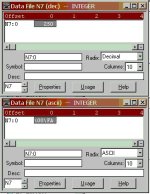rghill76
Guest
R
I am working with a SLC5/05, RSLogix6 and a Linx6200 Printer. The printer accepts commands in ASCII code sent out as strings. I am trying to send out parameters to the printer but I need some backslashes to separate my data or the printer will not accept it.
ex, I need to make the number 250 dec (FAh) to look like \FA\00
ST130:0 = "0"
ST130:1 = "0"
ST130:2 = "F"
ST130:3 = "A"
Using ACN I can bring them together, but is there any way to get the backslashes in there? What I would like to do is to have
ST130:4 = "\".
Any help would be much appreciated.
ex, I need to make the number 250 dec (FAh) to look like \FA\00
ST130:0 = "0"
ST130:1 = "0"
ST130:2 = "F"
ST130:3 = "A"
Using ACN I can bring them together, but is there any way to get the backslashes in there? What I would like to do is to have
ST130:4 = "\".
Any help would be much appreciated.




